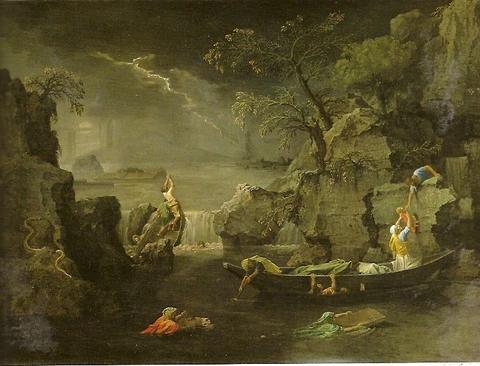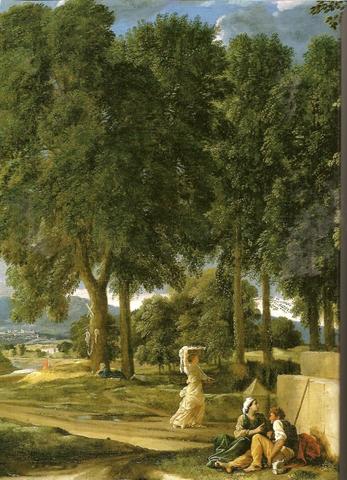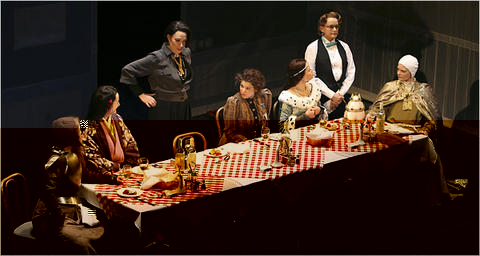Ellen and Jim Have a Blog, Too
We are two part-time academics. Ellen teaches in the English department and Jim in the IT program at George Mason University.


New York Journal (1): Patrick Stewart, Poussin, & Top Girls · 25 April 08
So.
Friday, 4/25:
Jim journalizing:
We arrived yesterday afternoon. We had dinner with a blogfriend of Ellen’s. We dined and drank at the Brasserie on 65th: the duck was really excellent; the conversation even better. (Ellen here: wonderful gift of two hours joyful commune. A high point of the trip, to begin with!)
Saw the Patrick Stewart MacBeth.
The production is really bad. Witches aren’t nurses. The Soviet references don’t work. The murder of Banquo becomes confused. Ending the first act in the middle of the banquet scene, while it enables the director to have his cake and eat it too (the end of the first act, Banquo is real, the beginning of the second act, Banquo is a figment of MacBeth’s imagination), misses the point (and there’s far too much business in the banquet scene, slowing it up, taken, I’m told, from Montefiore’s The Court of the Red Czar). The supporting performances are weak. MacDuff descends to rant too quickly, as does Lady MacBeth, and Malcolm in his final speech.
But Patrick Stewart’s performance is a jewel. He speaks the verse beautifully. His emotional range is full. I don’t think I’ve seen a better scene with the murderers (and his sandwich making capabilities are impressive). He drew a deserved laugh at “cream-faced loon”. Many of the key scenes he’s otherwise engaged: “We will proceed no further in this business” while he’s decanting the wine; “In them nature’s copy’s not eterne” while he’s dressing for dinner. His portrayal of MacBeth’s relationship with Lady MacBeth is convincing in its domestic, its sexual and its political aspects.
This morning to the Poussin Landscapes at the Met. But we must now to dinner. I (or Ellen) will continue later.
Saturday, 4/26:
Ellen journalizing:
We got to the Metropolitan museum yesterday morning just as it was opening. Lucky for that meant we were almost alone in the Poussin rooms for the first half hour; by the time we left while it was not as crowded as the equally large Courbet exhibit, there had begun to be too many people and a buzz of noise slightly too loud for the absorbed contemplation the astonishingly beautiful paintings rich with meaning ask of the viewer. I had been aware that what counts intensely about Poussin’s is the landscape, but hitherto I’d only seen the same few over and over again, together with religious allegories, and I was prepared to be disappointed by having only a few extraordinary pictures to see amidst a selection of dead religious allegories.
I learned: Nicolas Poussin (1594-1665) painted a very large number of great landscapes with figures in them that yield their meaning by their being made figures of classical history and myth embedded in ironic tragedy or by what is happening to the figure in front of us in the picture. The problem is most of Poussin’s pictures are scattered across many museums, some obscure and in out-of-the-way places (there are places which are out of the way but let’s not give examples), and many in owned individually (“private collection” is the euphemism). Well a large number of the pictures in the many rooms were wrenched out of these hidden houses and came from museums in small towns across western and eastern Europe too; the usual ones from London and Paris, DC, and Italy were there too.
Jim and I were entranced and absorbed into shared sudden good talk by all but the pin-ups (Poussin had to make a living in the way Titian did) and occasional miscalculations (one with a crazed self-flagellator in the central space, three strained gospel ones). We went through the exhibit twice and then began to go back and forth between sets of our favorites. These were for both of us: Landscape with the Ashes of Phocion

Detail at center from Landscape with Ashes of Phocion;
Travellers Resting, also called A Roman Road, Landscape with a Man Washing his Feet at a Fountain, also called Landscape with a Dirt Road, Blind Orion, Landscape with Eurydice and Orpheus, Landscape with a Storm, Landscape with a Calm, with Diogenes. And then we had our individual favorites, among them Apollo and a Nymph (a cruel rape, terrifying satyr), a number of those once owned by Joshua Reynolds (according to his titles, Morning and Evening [a parody of the holy family with a scary satyr hidden in the rocks the family is headed for]), and I loved Poussin’s brother-in-law’s picturesque sketches (dissed by the curators as “not analytical” aka not Poussin), and the landscape parts of the Seasons, except for Winter, the whoel of which is stunning.

Winter: A Flood (little known)
How to put into words what is so uplifting while filling you with thoughts of the terrors and suffering and mystery of individual human existences?

This mysterious woman from Man Washing His Feet made me think of Radcliffe’s heroines
Poussin makes a stage of idyllic beauty that breaks your heart: its center is often a startlingly luminous horizon; the landscape is filled with natural objects studied and transformed so as to project tranquillity, peace, and yet hard difficulty when it comes to living in it. Very common: in the center is some ravaged figure, often a woman who is or has been raped, or whose beloved has been unjustly murdered or is about to be destroyed. We thought repeatedly of Auden’s poem about Icarus (from Breughel) where as the tragedy goes on all around are people and a dog getting on with life indifferent to the spectacle of grief and loss. Not that that the figures scattered to the side or back, or as large in front are typically content: they are often exhausted, hot (washing one’s feet is a repeated motif), desperate to join some ship or group which is itself hard at some work. Plenty of figures just sit there, and there are mysterious contemplatives, and doubles and variants on the central figures too. The famous The Arcadian Shepherds, also known as Et in Arcadia Ego seemed to us to be typical tiny part of a Poussin painting for once put in the center. I could type out some of what Diderot and Hazlitt wrote; when we get home I’ll link some of their prose descriptions in.
After we told ourselves we had to leave them at some point and we had been there 2 hours, we had little patience for the posing and phoniness of Courbet. The rooms were crowded, but we did manage to see some of his landscapes that come near to being Corot (who did some landscapes in honor of Poussin where he painted a realistic version of the imagined picture) and three startlingly good caves.
By then the museum had become noisy, a place of distraction so with a glance here and there we left, took the subway back to near our hotel, bought lunch in Pret a Manger and took it upstairs with us to our room to eat and rest.
It was then we decided we’d go (as we are doing today) to the Bronx Botanical Gardens. I’ve never been, and there is an antique furniture show and big exhibit of Darwin perceived as gardener (not hard as in effect he was). The Gardens are not far from where I lived as a little girl too. The last couple of visits to NYC we have been going out to the suburbs: twice to the Brooklyn Museum (which I recommend to anyone who’s not been).
We forged forth to tickets around 2 and were amused to find the line for musicals went round 5 circles of people and each circle was thick with people, while the lines for dramatic plays was almost not visible as a line by 2:30. Near 3 we did have a respectable tail of people (say 20 or so). So from now on waiting on line for a play will not be a hour long ordeal at minimum. We went for Caryl Churchill’s Top Girls.
Then past 42nd Street from 8th Avenue (which we had walked to, just to see it), and onto the New York Public Library for the gardens, Internet (to see what was available), and two small exhibits, one of what was made of Milton by other writers and artists in later centuries (well, the musical accompaniment was lovely), some unexpected Corots and Daubignys in a third floor corridor, and then onto to Williams Club for a drink, and the unexpected real pleasure (but isn’t happiness often a matter of luck) of more good conversation with a couple who for the time being seemed carbon copies of our situations in life: 50s, with grown children, semi-academic, at the same place in life, with similar sense of humor, outlook and an ability to down drinks.
I keep falling into conversations with people this time. I did with a young man who was sitting next to me at Top Girls. Alas, he kept saying what is it about, and it’s terrible and I didn’t have the nerve to tell him it’s about women’s real lives, an argument within feminism. Its Dinner Party as opposed to Judy Chicago’s, filled with women who have suffered for being women, Griselda, Lady Nijo, Isabella Bird, even those in worldly terms famous and successful (e.g., the mythic Pope Joan), or never given a chance.

Ana Reeder, left, Jennifer Ikeda, Elizabeth Marvel, Marisa Tomei, Mary Catherine Garrison, Mary Beth Hurt and Martha Plimpton.
The second two acts show women’s lives have not improved a bit since feminism, nor will they. Partly the first act floored him because he had never heard of Lady Nijo or Isabella Bird, and who was Griselda anyway (how could I tell him Mrs. Spitzer played Griselda recently?). He did say the play came alive in the second act when we were into the (by implication) bitter interviewing segments, and by the third act poor Jim had woken (we had overeaten and drunk too much for dinner at an Indian restaurant) and I began also to talk to Jim afterwards.
I was much moved by the third act, which took place in Ipswich (Judy, did you know that?). The 2nd and 3rd acts showed us how individual lives today are wrecked, and the lack of understanding caught up in the Thatcherite scorn for those who don’t “succeed” as “stupid, lazy and frightened.” Our final heroine, Joyce, the stay-at-home woman, was none of these, only someone with 4 cleaning jobs to support a daughter her sister placed with her when the sister had the child out-of-wedlock and he child would have prevented the sister from taking a good paying-job in London. Joyce’s husband had deserted 3 years ago, after Joyce had a miscarriage. Joyce gave the moral.
The young man I talked to did tell me Gloria Steinem was in the next row after us. She looked young.
But now I must go and shower and dress. More anon.
Ellen
--
Posted by: Jim
* * *
Comment
- From Nick:
“Good to read your first blog – the visit sounds great to me, especially the Poussin. I admire your stamina tremendously!”
— Elinor Apr 28, 1:03pm # - From Diana:
“Ah, welcome home, dear Ellen! I saw you were back, on 18th century. Sounds like you had a very stimulating time, and it was improved even more by some pleasant socializing. A perfect visit, in being only too short.”
— Elinor Apr 28, 1:03pm # - P. S. On Landscape with Phocion’s Ashes:
Alas, I could not manage the whole of the picture, so you are missing the grieving woman under the tree to the left of center, and the mysterious contemplative on her way to a temple yet further up and on, and what further people are doing (getting on with their doggy lives as Auden might say), while Phocion’s wife grieves and her servant keeps a look out.
Ellen
— Elinor Apr 29, 8:46am # - From Kathy C:
“Dear Ellen,
I’m glad you’re back and have been reading your blog, which is as close as I’m ever going to get to the culture of NYC. I loved reading about “Macbeth,” going early to the museum, etc.. .”
— Elinor Apr 29, 11:33am # - From Judy:
“I have read your blogs on New York (though I haven’t checked today so maybe you have put up a new one, I’ll look in a minute!) and it sounds as if you packed in a lot of good things. I have never seen Top Girls and didn’t realise that part of it was set in Ipswich, but Paul says he thinks he had heard this somewhere – he has a vague feeling the work might have been premiered or tried out in our theatre, the Wolsey (just about everything in Ipswich is called Wolsey this or Cardinal that, after the town’s “most famous son”!)”
— Elinor Apr 29, 6:27pm # - Dear Judy,
Jim and I looked up in a volume of Churchill’s plays that we have and discovered the first performance of Top Girls was at the Royal Court Theatre in 1982. She was a resident dramatist there at the time. She was born in London, so I don’t know why she picks Ipswich as the “ultimate provincial town.”
Jim told me that indeed Wolsey is remembered as the butcher’s son who “made good” from Ipswich.
I have your Christmas card with a block of Ipswich under snow.
Ellen
— Elinor Apr 29, 8:06pm # - Ben Brantley's review in the New York Times of Caryl Churchill’s Top Girls still playing
on Broadway in NYC:
http://theater2.nytimes.com/
2008/05/08/theater/reviews/08girl.html?scp=1&sq=top+girls&st=nyt
I have a quarrel with the review. I’m glad the production is praised, but the tone and meaning of the piece and night is somewhat evaded. It’s dark and caustic throughout; it’s funny all right but not out of triumph. The final scene of the woman in Ipswich with no options but 4 part time jobs unless she were to abandon the daughter who is not hers, but her sister’s—and given her so the sister can “get ahead,” have her triumph in life is the one we end on—at length. And the opening scene of the historical figures show them to be anything but powerful. Indeed it’s a riposte to Judy Chicago’ Dinner Party. To be fair, it’s really the headline and first paragraph’s tone that misrepresents the play,and it’s a matter of interpretation after all. I wouldn’t say the play leaves us afraid; I’d say it leaves us angry at those who call those who don’t have worldly success “ugly, stupid, and frightened” without looking to why they are judged so.
Ellen
— Elinor May 9, 10:59am #
commenting closed for this article
